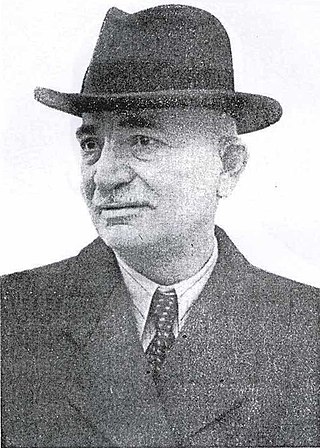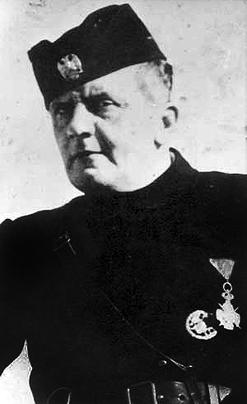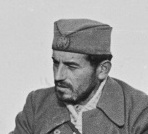
The Chetniks, formally the Chetnik Detachments of the Yugoslav Army, and also the Yugoslav Army in the Homeland and the Ravna Gora Movement, was a Yugoslav royalist and Serbian nationalist movement and guerrilla force in Axis-occupied Yugoslavia. Although it was not a homogeneous movement, it was led by Draža Mihailović. While it was anti-Axis in its long-term goals and engaged in marginal resistance activities for limited periods, it also engaged in tactical or selective collaboration with Axis forces for almost all of the war. The Chetnik movement adopted a policy of collaboration with regard to the Axis, and engaged in cooperation to one degree or another by both establishing a modus vivendi and operating as "legalised" auxiliary forces under Axis control. Over a period of time, and in different parts of the country, the movement was progressively drawn into collaboration agreements: first with the puppet Government of National Salvation in the German-occupied territory of Serbia, then with the Italians in occupied Dalmatia and Montenegro, with some of the Ustaše forces in northern Bosnia, and, after the Italian capitulation in September 1943, with the Germans directly.

Dragoljub "Draža" Mihailović was a Yugoslav Serb general during World War II. He was the leader of the Chetnik Detachments of the Yugoslav Army (Chetniks), a royalist and nationalist movement and guerrilla force established following the German invasion of Yugoslavia in 1941.

Sekula Drljević was a Montenegrin nationalist, Yugoslav jurist, politician, orator, and theoretician. During World War II, he became a collaborator with Nazi Germany and Fascist Italy, and cooperated with the Ustaše in the German puppet state of Croatia.

The Territory of the Military Commander in Serbia was the area of the Kingdom of Yugoslavia that was placed under a military government of occupation by the Wehrmacht following the invasion, occupation and dismantling of Yugoslavia in April 1941. The territory included only most of modern central Serbia, with the addition of the northern part of Kosovo, and the Banat. This territory was the only area of partitioned Yugoslavia in which the German occupants established a military government. This was due to the key rail and the Danube transport routes that passed through it, and its valuable resources, particularly non-ferrous metals. On 22 April 1941, the territory was placed under the supreme authority of the German military commander in Serbia, with the day-to-day administration of the territory under the control of the chief of the military administration staff. The lines of command and control in the occupied territory were never unified, and were made more complex by the appointment of direct representatives of senior Nazi figures such as Reichsführer-SS Heinrich Himmler, Reichsmarschall Hermann Göring, and Reichsminister Joachim von Ribbentrop. The Germans used Bulgarian troops to assist in the occupation, but they were at all times under German control. Sources variously describe the territory as a puppet state, a protectorate, a "special administrative province", or describe it as having a puppet government. The military commander in Serbia had very limited German garrison troops and police detachments to maintain order, but could request assistance from a corps of three divisions of poorly-equipped occupation troops.

The Serbian State Guard was a collaborationist paramilitary force used to impose law and order within the German occupied territory of Serbia during World War II. It was formed from two former Yugoslav gendarmerie regiments, was created with the approval of the German military authorities, and for a long period was controlled by the Higher SS and Police Leader in the occupied territory. It was also known as the Nedićevci after the leader of the German-installed Serbian puppet government, General Milan Nedić, who eventually gained control of its operations. It assisted the Germans in imposing one of the most brutal occupation regimes in occupied Europe and helped guard and execute prisoners at the Banjica concentration camp in Belgrade. Its leaders and much of the rank and file were sympathetic to the Chetnik movement of Draža Mihailović, and it was purged by the Germans on several occasions for that reason. In October 1944, as the Soviet Red Army closed on Belgrade, the SDS was transferred to Mihailović's control by a member of the fleeing Nedić administration, but it quickly disintegrated during its withdrawal west, with only a small number of former SDS members being captured by the British near the Italian-Yugoslav border in May 1945.

The Battle of Lijevče Field was fought between 30 March and 8 April 1945 between the Croatian Armed Forces and Chetnik forces on the Lijevče field near Banja Luka in what was then the Independent State of Croatia (NDH).

The Italian governorate of Montenegro existed from October 1941 to September 1943 as an occupied territory under military government of Fascist Italy during World War II. Although the Italians had intended to establish a quasi-independent Montenegrin kingdom, these plans were permanently shelved after a popular uprising in July 1941. Following the Italian surrender in September 1943, the territory of Montenegro was occupied by German forces which withdrew in December 1944.

Dobroslav Jevđević was a Bosnian Serb politician and self-appointed Chetnik commander in the Herzegovina region of the Axis-occupied Kingdom of Yugoslavia during World War II. He was a member of the interwar Chetnik Association and the Organisation of Yugoslav Nationalists, a Yugoslav National Party member of the National Assembly, and a leader of the opposition to King Alexander between 1929 and 1934. The following year, he became the propaganda chief for the Yugoslav government.

Pavle Đurišić was a Montenegrin Serb regular officer of the Royal Yugoslav Army who became a Chetnik commander (vojvoda) and led a significant proportion of the Chetniks in Montenegro during World War II. He distinguished himself and became one of the main commanders during the popular uprising against the Italians in Montenegro in July 1941, but later collaborated with the Italians in actions against the Communist-led Yugoslav Partisans. In 1943, his troops carried out several massacres against the Muslim population of Bosnia, Herzegovina, and the Sandžak in which an estimated 10,000 people were killed between January and March, including thousands of women, children, and the elderly. He then led his troops during their participation in the anti-Partisan Case White offensive alongside Italian forces. Đurišić was captured by the Germans in May 1943, escaped, and was recaptured.
The Montenegrin Volunteer Corps was a collaborationist military formation that was created in the spring of 1944 under Chetnik leader Pavle Đurišić with assistance from the Germans, Milan Nedić, and Dimitrije Ljotić. It was formally a part of the Serbian Volunteer Corps. The Corps consisted of some of Đurišić's former troopers that were released from German captivity, but the majority were Chetniks that remained in Montenegro under the name of "national forces". Đurišić developed the force in Montenegro and Sandžak and it consisted of between 7,000 and 8,000 men.
The Government of National Salvation, also referred to as Nedić's government and Nedić's regime, was the colloquial name of the second Serbian collaborationist puppet government established in the German-occupied territory of Serbia during World War II in Yugoslavia. Appointed by the German Military Commander in Serbia, it operated from 29 August 1941 to 4 October 1944. Unlike the Independent State of Croatia, the regime in occupied Serbia was never accorded status in international law and did not enjoy formal diplomatic recognition of the Axis powers.

Vojislav Lukačević was a Serbian Chetnik commander in the Kingdom of Yugoslavia during World War II. At the outbreak of war, he held the rank of captain of the reserves in the Royal Yugoslav Army.

Petar Baćović was a Bosnian Serb Chetnik commander within occupied Yugoslavia during World War II. From the summer of 1941 until April 1942, he headed the cabinet of the Ministry of Internal Affairs for Milan Nedić's puppet Government of National Salvation in the German-occupied territory of Serbia. In May and June 1942, Baćović participated in the joint Italian-Chetnik offensive against the Yugoslav Partisans in Montenegro. In July 1942, Baćović was appointed by the Chetnik leader Draža Mihailović and his Supreme Command as the commander of the Chetnik units in the regions of eastern Bosnia and Herzegovina within the Axis puppet state, the Independent State of Croatia. In this role, Baćović continued collaborating with the Italians against the Yugoslav Partisans, with his Chetniks formally recognised as Italian auxiliaries from mid-1942.

Lieutenant Colonel Zaharije Ostojić was a Montenegrin Serb and Yugoslav military officer who served as the chief of the operational, organisational and intelligence branches of the Chetnik Supreme Command led by Draža Mihailović in Yugoslavia during World War II. He was a major in the Royal Yugoslav Army Air Force prior to the Axis invasion of Yugoslavia, and was involved in the coup that deposed Prince Paul of Yugoslavia on 27 March 1941. After the coup, he escorted Prince Paul to exile in Greece, and was in Cairo during the invasion in April. In September 1941, he was landed on the coast of the Italian governorate of Montenegro along with the British Special Operations Executive officer Captain Bill Hudson and two companions. He escorted Hudson to the German-occupied territory of Serbia and introduced him to the Yugoslav Partisan leader Josip Broz Tito at Užice, then accompanied Hudson to Ravna Gora to meet Mihailović. Ostojić soon became Mihailović's chief of staff, and after the German attempt to capture the Chetnik leader during Operation Mihailovic in December 1941, brought the Chetnik Supreme Command staff to Montenegro where they were re-united with Mihailović in June 1942. During the remainder of 1942, Ostojić launched a counter-attack against Ustaše troops of the Independent State of Croatia returning to the eastern Bosnian town of Foča where they were expected to continue their genocidal anti-Serb policies. As many as 2,000 local Muslims were subsequently killed in the town by forces under Ostojić's command. Ostojić later oversaw large-scale massacres of civilians and burning of Muslim villages in the border region between Montenegro and the Sandžak.

Dragomir "Dragiša" Vasić was a Serbian lawyer, writer and publicist who became one of the chief Chetnik ideologues during World War II. He finished law school in Belgrade and fought with the Serbian Army during the Balkan Wars and World War I. During the interwar period, he worked as a lawyer and represented a number of communist defendants. He was a member of the Serbian Academy of Sciences and Arts and became a correspondent at the Academy of Fine Arts on 12 February 1934. In 1936, he joined the Serbian Cultural Club and later became its vice-president. He is reported to have developed connections with Soviet intelligence services during this time.

The Dinara Division was an irregular Chetnik formation that existed during the World War II Axis occupation of Yugoslavia that largely operated as auxiliaries of the occupying forces and fought the Yugoslav Partisans. Organized in 1942 with assistance from Ilija Trifunović-Birčanin and headed by Momčilo Đujić, the division incorporated commanders in Bosnia and Herzegovina, northern Dalmatia, and the Lika region. The division was under the control of supreme Chetnik commander Draža Mihailović and received aid from Dimitrije Ljotić, leader of the Serbian Volunteer Corps, and Milan Nedić, head of the Serbian puppet Government of National Salvation.
Bajo Stanišić was a Montenegrin Serb officer of the Royal Yugoslav Army, who was one of the participants of the Uprising in Montenegro against the Italian occupation forces in 1941. After the suppression of the uprising, he became one of the commanders of the Chetnik units in Montenegro and openly collaborated with Fascist Italy until his death in 1943.

Montenegrin National Army was an army whose supreme commander was Montenegrin collaborationist politician and separatist Sekula Drljević. When Pavle Đurišić retreated with his forces from Montenegro toward Slovenia in 1945, he made a safe-conduct agreement with Drljević. According to this contract Đurišićs forces were aligned with Drljević as the "Montenegrin National Army" with Đurišić retaining operational command, based on instructions of Drljević.

The attack on Kruševac was an attack of Yugoslav rebels on Axis-held Kruševac in the German-occupied territory of Serbia which lasted between 23 and 27 September 1941 during World War II.

Predrag Raković was a Yugoslav military officer who joined the Chetnik forces of Draža Mihailović after the Axis invasion of Yugoslavia in April 1941 during World War II. He became commander of the Chetnik 2nd Ravna Gora Corps and collaborated with the German-installed puppet government in the German-occupied territory of Serbia and later directly with the Germans against the rival communist-led Yugoslav Partisans. His forces briefly cooperated with Soviet forces against the Germans in October 1944, but faced with Soviet demands that they lay down their weapons or join the Partisans, they withdrew from occupied Serbia.
















